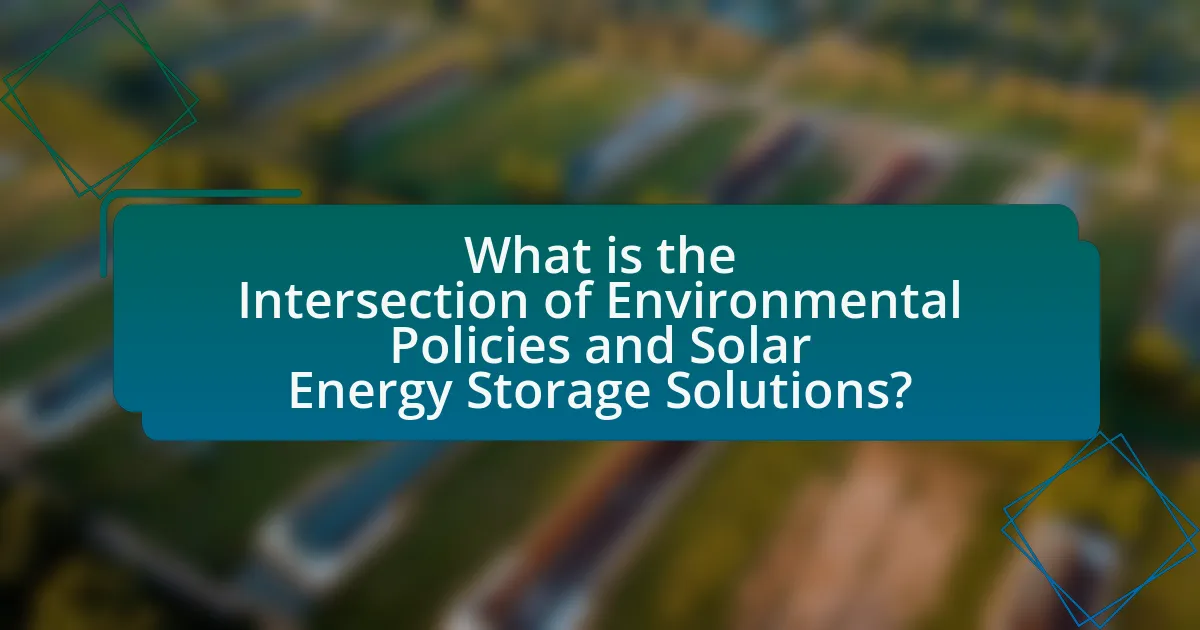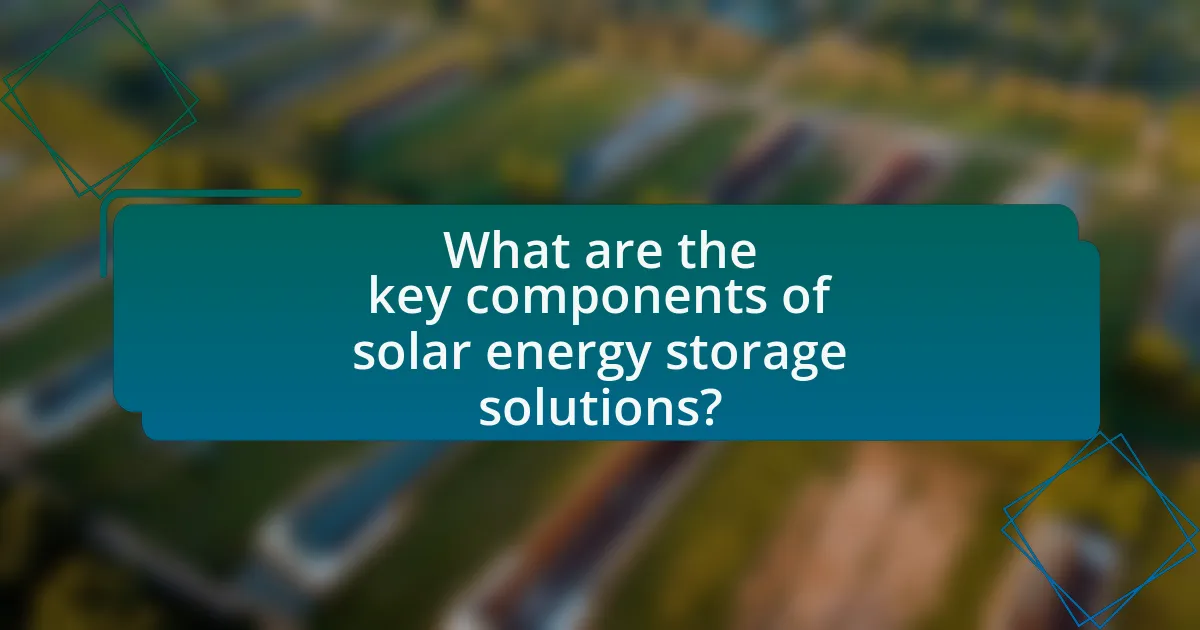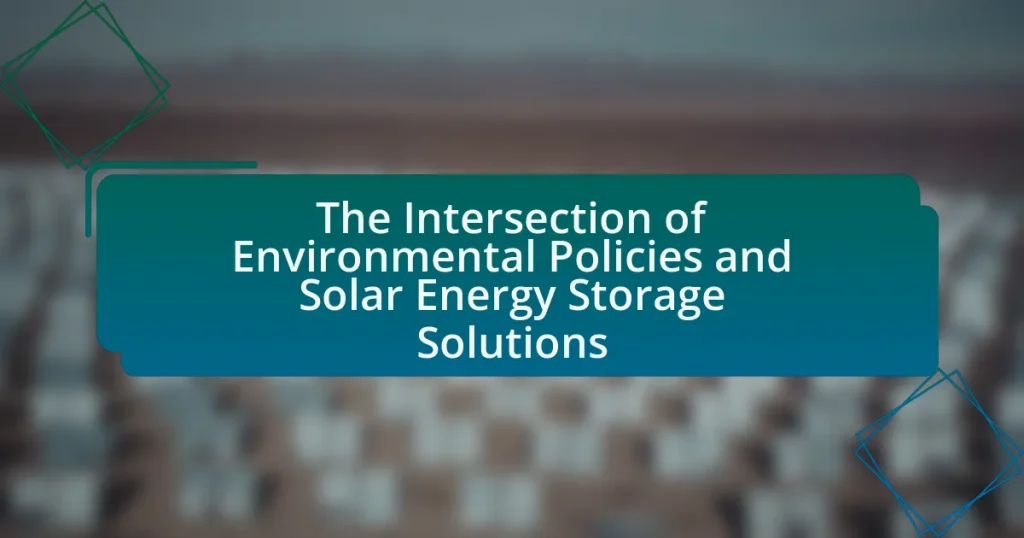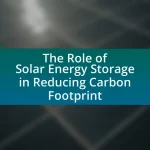The article examines the intersection of environmental policies and solar energy storage solutions, highlighting how these policies promote sustainable energy practices that reduce greenhouse gas emissions and enhance energy efficiency. It discusses the influence of specific environmental policies, such as tax credits and renewable energy standards, on the adoption and development of solar energy storage technologies. Additionally, the article addresses the importance of solar energy storage in achieving sustainability goals, the challenges posed by regulatory inconsistencies and high costs, and the role of collaboration between stakeholders in overcoming these challenges. Key components and types of solar energy storage technologies, along with their advantages and disadvantages, are also analyzed to provide a comprehensive understanding of their impact on the renewable energy landscape.
What is the Intersection of Environmental Policies and Solar Energy Storage Solutions?


The intersection of environmental policies and solar energy storage solutions lies in the promotion of sustainable energy practices that reduce greenhouse gas emissions and enhance energy efficiency. Environmental policies often incentivize the adoption of renewable energy technologies, including solar energy, by providing tax credits, subsidies, and regulatory support. For instance, the U.S. federal solar investment tax credit (ITC) has significantly boosted solar installations, which are complemented by energy storage systems that allow for better management of energy supply and demand. This synergy not only supports the transition to a low-carbon economy but also aligns with international climate agreements, such as the Paris Agreement, which aims to limit global warming by reducing reliance on fossil fuels.
How do environmental policies influence solar energy storage solutions?
Environmental policies significantly influence solar energy storage solutions by promoting the adoption of renewable energy technologies and establishing regulatory frameworks that incentivize energy storage investments. For instance, policies such as tax credits, grants, and renewable portfolio standards encourage the integration of solar energy systems with storage capabilities, thereby enhancing grid reliability and reducing dependence on fossil fuels. Additionally, regulations aimed at reducing greenhouse gas emissions compel utilities and energy providers to invest in energy storage solutions that can store excess solar energy for later use, facilitating a more sustainable energy ecosystem.
What specific environmental policies are relevant to solar energy storage?
Specific environmental policies relevant to solar energy storage include the Renewable Energy Standards (RES), which mandate a certain percentage of energy to come from renewable sources, and the Energy Storage Investment Tax Credit (ITC), which provides tax incentives for solar energy storage systems. These policies encourage the integration of solar energy storage into the grid, promoting cleaner energy use and reducing greenhouse gas emissions. For instance, the ITC allows for a 26% tax credit for solar energy systems installed before 2023, incentivizing investment in solar storage technologies.
How do these policies impact the development of solar energy storage technologies?
Environmental policies significantly accelerate the development of solar energy storage technologies by providing financial incentives, regulatory frameworks, and research funding. For instance, policies such as tax credits and subsidies lower the cost of solar installations and storage systems, making them more accessible to consumers and businesses. According to the U.S. Energy Information Administration, the Investment Tax Credit has contributed to a substantial increase in solar capacity, which in turn drives innovation in storage solutions to manage energy supply and demand effectively. Furthermore, regulations that mandate renewable energy usage encourage companies to invest in advanced storage technologies, fostering competition and technological advancements in the sector.
Why is solar energy storage important in the context of environmental policies?
Solar energy storage is crucial in the context of environmental policies because it enhances the reliability and efficiency of renewable energy systems. By storing excess solar energy generated during peak sunlight hours, energy storage solutions enable a consistent power supply, reducing reliance on fossil fuels and lowering greenhouse gas emissions. According to the International Energy Agency, integrating energy storage with solar power can increase the share of renewables in the energy mix, thereby supporting global climate goals and national energy policies aimed at sustainability.
What role does solar energy storage play in achieving sustainability goals?
Solar energy storage is crucial for achieving sustainability goals as it enables the efficient use of renewable energy by storing excess energy generated during peak sunlight hours for use during periods of low generation. This capability enhances grid stability, reduces reliance on fossil fuels, and minimizes greenhouse gas emissions. For instance, according to the International Renewable Energy Agency, integrating energy storage with solar power can increase the share of renewables in the energy mix, thereby supporting global climate targets and promoting energy independence.
How does solar energy storage contribute to reducing carbon emissions?
Solar energy storage significantly contributes to reducing carbon emissions by enabling the use of renewable energy even when sunlight is not available. This technology allows excess solar energy generated during the day to be stored and used later, decreasing reliance on fossil fuels for electricity generation. According to the International Energy Agency, integrating energy storage with solar power can reduce greenhouse gas emissions by up to 70% in certain regions, as it minimizes the need for carbon-intensive energy sources during peak demand times.
What are the key components of solar energy storage solutions?


The key components of solar energy storage solutions include batteries, inverters, charge controllers, and energy management systems. Batteries, such as lithium-ion or lead-acid, store excess energy generated by solar panels for later use. Inverters convert the stored DC electricity from batteries into AC electricity for household use. Charge controllers regulate the flow of energy to and from the batteries, preventing overcharging and ensuring optimal performance. Energy management systems monitor and optimize energy usage, enhancing efficiency and integration with the grid. These components work together to provide reliable and efficient energy storage, enabling the effective use of solar energy.
What types of solar energy storage technologies are available?
There are several types of solar energy storage technologies available, including lithium-ion batteries, flow batteries, pumped hydro storage, and thermal energy storage. Lithium-ion batteries are widely used due to their high energy density and efficiency, making them suitable for residential and commercial applications. Flow batteries, which store energy in liquid electrolytes, offer scalability and longer discharge times, ideal for larger installations. Pumped hydro storage utilizes gravitational potential energy by pumping water to a higher elevation during excess energy production and releasing it to generate electricity when needed. Thermal energy storage captures heat from solar energy for later use, often in concentrated solar power systems. These technologies collectively enhance the reliability and efficiency of solar energy systems, supporting the transition to renewable energy sources.
How do lithium-ion batteries compare to other storage technologies?
Lithium-ion batteries are generally more efficient and have a higher energy density compared to other storage technologies such as lead-acid batteries and pumped hydro storage. Specifically, lithium-ion batteries can achieve energy densities of 150-250 Wh/kg, while lead-acid batteries typically range from 30-50 Wh/kg. Additionally, lithium-ion batteries have a longer cycle life, often exceeding 2,000 cycles, compared to lead-acid batteries, which usually last around 500-1,000 cycles. This efficiency and longevity make lithium-ion batteries a preferred choice for applications in renewable energy systems, particularly in solar energy storage, where space and weight are critical factors.
What are the advantages and disadvantages of different solar energy storage systems?
Different solar energy storage systems, such as lithium-ion batteries, flow batteries, and pumped hydro storage, each have distinct advantages and disadvantages. Lithium-ion batteries are highly efficient, with round-trip efficiencies around 90-95%, and they have a compact size, making them suitable for residential use. However, they have a limited lifespan of about 5-15 years and can be expensive to replace. Flow batteries offer longer lifespans and scalability, but they typically have lower energy densities and higher initial costs. Pumped hydro storage is highly efficient and can store large amounts of energy, but it requires significant geographical and environmental considerations, making it less feasible in certain locations. Each system’s effectiveness is influenced by factors such as cost, efficiency, lifespan, and environmental impact, which must be weighed when selecting a solar energy storage solution.
How do these technologies align with current environmental policies?
Solar energy storage technologies align with current environmental policies by facilitating the transition to renewable energy sources and reducing greenhouse gas emissions. These technologies support policies aimed at increasing energy efficiency and promoting clean energy, such as the U.S. Clean Power Plan, which encourages the use of renewable energy to meet carbon reduction targets. Additionally, solar energy storage systems enhance grid stability and reliability, aligning with policies that prioritize energy resilience and sustainability. For instance, the International Energy Agency reports that energy storage can significantly contribute to achieving climate goals by enabling higher penetration of renewable energy into the grid.
What incentives exist for adopting solar energy storage solutions under environmental regulations?
Incentives for adopting solar energy storage solutions under environmental regulations include tax credits, rebates, and grants that promote renewable energy technologies. For instance, the Federal Investment Tax Credit (ITC) allows homeowners and businesses to deduct a significant percentage of the cost of solar energy systems from their federal taxes, which can be as high as 26% through 2022. Additionally, various states offer their own incentives, such as California’s Self-Generation Incentive Program (SGIP), which provides financial incentives for energy storage systems that help reduce greenhouse gas emissions. These incentives are designed to encourage the transition to cleaner energy sources, thereby supporting environmental goals and reducing reliance on fossil fuels.
How do government subsidies affect the solar energy storage market?
Government subsidies significantly enhance the solar energy storage market by lowering costs and increasing adoption rates. These financial incentives, such as tax credits and grants, reduce the initial investment required for solar storage systems, making them more accessible to consumers and businesses. For instance, the U.S. federal solar investment tax credit allows homeowners to deduct a percentage of the cost of solar systems from their federal taxes, which has been shown to boost installations. According to the Solar Energy Industries Association, the U.S. solar market grew by 167% from 2010 to 2020, partly due to such subsidies. Additionally, subsidies can stimulate research and development, leading to technological advancements that further improve efficiency and reduce costs in the solar energy storage sector.
What challenges exist at the intersection of environmental policies and solar energy storage solutions?


Challenges at the intersection of environmental policies and solar energy storage solutions include regulatory inconsistencies, high costs, and environmental impacts of battery production. Regulatory inconsistencies arise when policies vary significantly across regions, creating uncertainty for investors and developers in solar energy storage projects. High costs, particularly for advanced battery technologies, hinder widespread adoption despite the decreasing prices of solar panels. Additionally, the environmental impacts of battery production, including resource extraction and waste management, pose significant challenges to achieving sustainable energy goals. For instance, lithium extraction for batteries can lead to water depletion and pollution, contradicting the objectives of environmental policies aimed at protecting ecosystems.
What regulatory hurdles do solar energy storage solutions face?
Solar energy storage solutions face regulatory hurdles such as inconsistent state policies, interconnection standards, and permitting processes. These challenges arise because regulations vary significantly across states, leading to confusion and delays in project implementation. For instance, some states have supportive policies that encourage storage deployment, while others impose restrictive regulations that hinder progress. Additionally, interconnection standards can complicate the integration of storage systems with the grid, as utilities may have different requirements. Permitting processes can also be lengthy and complex, often requiring multiple approvals from various agencies, which can slow down the deployment of solar energy storage solutions.
How do local, state, and federal regulations differ in their approach to solar energy storage?
Local, state, and federal regulations differ significantly in their approach to solar energy storage, primarily in terms of incentives, permitting processes, and safety standards. Local regulations often focus on zoning laws and building codes that dictate where and how solar energy storage systems can be installed, while state regulations typically provide broader incentives such as tax credits and rebates to encourage adoption. Federal regulations, on the other hand, set national safety and performance standards for solar energy storage technologies, ensuring they meet specific criteria for reliability and safety. For example, the Federal Energy Regulatory Commission (FERC) oversees interconnection standards that affect how energy storage systems connect to the grid, while state-level policies may vary widely in their support for net metering or energy storage mandates.
What are the implications of these regulations for innovation in solar energy storage?
Regulations in the solar energy storage sector can significantly drive innovation by establishing clear standards and incentives for technological advancements. These regulations often promote research and development funding, which encourages companies to innovate in energy storage technologies, such as batteries with higher efficiency and longer life cycles. For instance, the U.S. Department of Energy’s initiatives have led to breakthroughs in lithium-ion battery technology, improving energy density and reducing costs. Furthermore, regulations that mandate renewable energy integration can stimulate the development of advanced storage solutions, ensuring that solar energy can be effectively stored and utilized, thereby enhancing grid reliability and resilience.
How can stakeholders overcome these challenges?
Stakeholders can overcome challenges in the intersection of environmental policies and solar energy storage solutions by fostering collaboration among government, industry, and community organizations. This collaboration can lead to the development of comprehensive policies that support renewable energy initiatives while addressing environmental concerns. For instance, joint efforts can result in streamlined regulations that facilitate the deployment of solar energy storage systems, as seen in California’s initiatives that promote both solar energy and battery storage through incentives and funding. Additionally, stakeholders can invest in research and development to innovate more efficient storage technologies, which can enhance the viability of solar energy. Evidence from the National Renewable Energy Laboratory indicates that advancements in battery technology can significantly reduce costs and improve performance, making solar energy more accessible and sustainable.
What strategies can be employed to advocate for more supportive policies?
To advocate for more supportive policies regarding solar energy storage solutions, stakeholders can employ strategies such as coalition building, public awareness campaigns, and direct engagement with policymakers. Coalition building involves forming alliances with environmental organizations, industry leaders, and community groups to amplify voices and share resources, which has been shown to enhance advocacy efforts. Public awareness campaigns can educate the public on the benefits of solar energy storage, thereby increasing demand for supportive policies; for instance, studies indicate that informed citizens are more likely to support renewable energy initiatives. Direct engagement with policymakers through meetings, testimonies, and providing data-driven research can influence legislative decisions, as evidenced by successful advocacy efforts in states that have implemented favorable solar policies after stakeholder engagement.
How can collaboration between industry and government enhance solar energy storage solutions?
Collaboration between industry and government can enhance solar energy storage solutions by facilitating research and development, streamlining regulations, and providing financial incentives. Joint efforts can lead to innovative technologies that improve storage efficiency and capacity, as seen in projects like the U.S. Department of Energy’s SunShot Initiative, which aims to reduce the cost of solar energy systems. Additionally, government support can help create a favorable regulatory environment that encourages private investment in storage technologies, ultimately accelerating the deployment of solar energy solutions.
What best practices should be followed when implementing solar energy storage solutions?
When implementing solar energy storage solutions, it is essential to conduct a thorough site assessment to determine the optimal location and configuration for the system. This assessment should include evaluating solar resource availability, local regulations, and grid connectivity. Additionally, selecting high-quality, compatible components such as batteries and inverters is crucial for ensuring system efficiency and longevity.
Regular maintenance and monitoring of the storage system are also best practices, as they help identify potential issues early and optimize performance. Furthermore, integrating advanced energy management systems can enhance the efficiency of energy use and storage.
According to the National Renewable Energy Laboratory, proper sizing of the storage system based on energy consumption patterns and solar generation capacity is vital for maximizing benefits and minimizing costs.
How can organizations ensure compliance with environmental policies while adopting solar energy storage?
Organizations can ensure compliance with environmental policies while adopting solar energy storage by implementing rigorous environmental management systems that align with regulatory requirements. These systems should include regular audits, monitoring of emissions, and adherence to local and national environmental regulations, such as the Clean Air Act and the Resource Conservation and Recovery Act.
Additionally, organizations should engage in stakeholder consultations to understand community concerns and incorporate sustainable practices in their solar energy storage projects. For instance, using environmentally friendly materials and technologies can minimize ecological impact. Furthermore, organizations can leverage certifications like ISO 14001, which provides a framework for effective environmental management, ensuring that their operations meet legal and other requirements.
By integrating these practices, organizations not only comply with environmental policies but also enhance their sustainability credentials, contributing to broader environmental goals.
What are the key considerations for maximizing the effectiveness of solar energy storage systems?
Key considerations for maximizing the effectiveness of solar energy storage systems include selecting the appropriate battery technology, optimizing system sizing, and implementing effective management strategies. Choosing the right battery technology, such as lithium-ion or flow batteries, impacts efficiency, lifespan, and cost-effectiveness. Proper system sizing ensures that the storage capacity aligns with energy generation and consumption patterns, preventing over-sizing or under-sizing that can lead to inefficiencies. Additionally, employing advanced management strategies, such as demand response and smart grid integration, enhances the overall performance and reliability of the storage system. These considerations are supported by studies indicating that optimized storage systems can improve energy utilization by up to 30%, thereby maximizing the benefits of solar energy.


